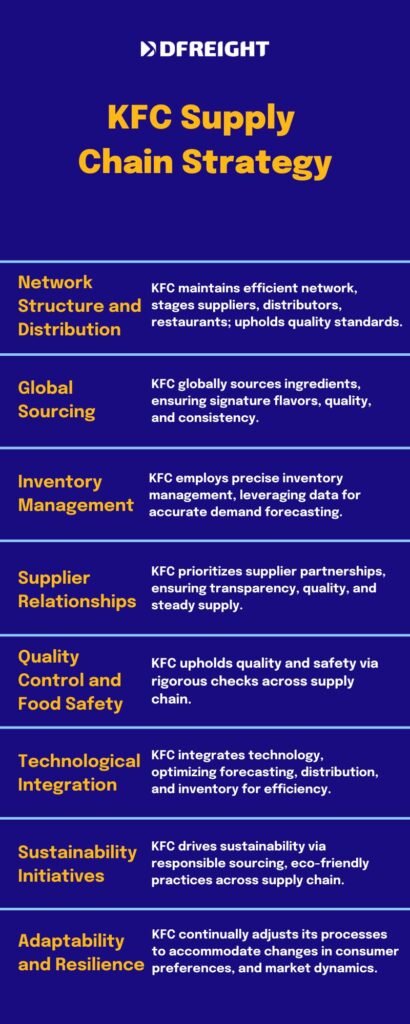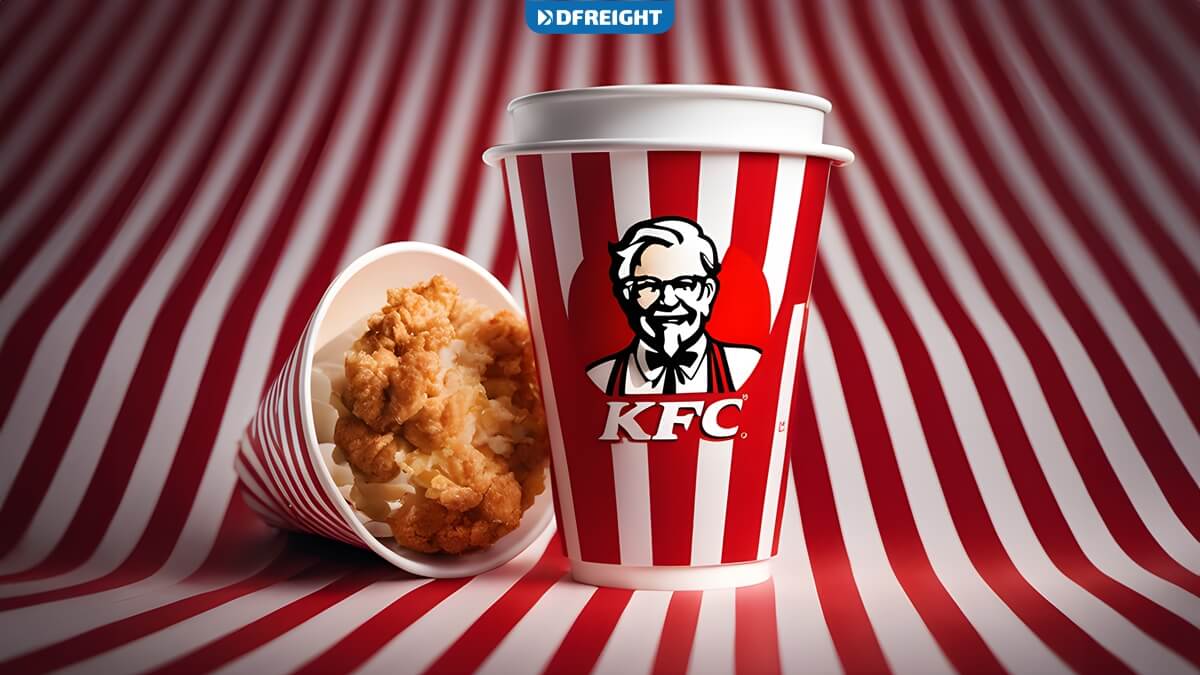In the bustling world of fast food, few names are as recognizable as KFC or Kentucky Fried Chicken. With its delectable range of fried chicken offerings and signature flavors, KFC has become a global phenomenon that has captured the hearts and palates of millions. Yet, behind the scenes of every finger-licking meal lies an intricate and well-orchestrated supply chain strategy that enables KFC to deliver its mouthwatering fare to eager customers worldwide consistently.
Unveil the future of supply chain management with DFreight, your ultimate digital freight forwarder. Our innovative online platform and mobile app bring efficiency and transparency to every step of your supply chain. Seamlessly manage shipments, track cargo in real-time, and optimize routes with just a few clicks. Experience the power of data-driven decision-making as we redefine how you connect with suppliers, distributors, and customers. Join us in transforming your supply chain strategy into a streamlined, agile, responsive powerhouse. Visit us today and embark on a journey toward smarter logistics with DFreight!
This blog post delves into the intriguing realm of KFC supply chain strategy. We’ll explore the integral role that supply chain management plays in the fast-food industry, where timely and reliable delivery of fresh ingredients and products is paramount. By understanding the intricate web of processes, partnerships, and technologies that underpin KFC’s supply chain, we gain insight into how the company has managed to maintain its iconic taste and quality across a sprawling global network of restaurants.
Table of Contents
KFC Supply Chain Strategy
Behind the enticing aroma of KFC‘s crispy fried chicken lies a sophisticated and meticulously designed supply chain network that spans the globe. From sourcing the freshest ingredients to ensuring timely delivery to thousands of restaurants, KFC’s supply chain strategy is a testament to efficient logistics, innovative technologies, and strategic partnerships.

1. Network Structure and Distribution: KFC’s supply chain is organized to ensure a seamless flow of ingredients and products. It comprises multiple stages, including suppliers, distributors, warehouses, and restaurant outlets. The distribution process involves efficiently moving raw materials and finished products from suppliers to restaurants, adhering to strict quality and safety standards.
2. Global Sourcing: KFC sources its ingredients from various regions to maintain its signature flavors and quality. Chicken, a cornerstone of KFC’s menu, is sourced from multiple poultry suppliers worldwide. Spices and herbs are procured from diverse locations to maintain consistency in taste across different markets.
3. Inventory Management and Demand Forecasting: KFC employs advanced inventory management techniques to prevent wastage and stockouts. The company uses data analytics and historical sales data to forecast demand accurately. This ensures each restaurant has the necessary ingredients to fulfill customer orders without overburdening storage space.
4. Supplier Relationships: Strong relationships with suppliers are crucial to KFC’s supply chain strategy. KFC collaborates closely with its suppliers, promoting transparency and quality assurance. This partnership-driven approach helps maintain consistency in ingredient quality and ensures a steady supply chain flow.
5. Quality Control and Food Safety: KFC prioritizes quality control and food safety throughout its supply chain. Rigorous inspections, audits, and quality checks are performed at various stages, from sourcing to delivery. This thorough approach ensures that only the finest ingredients enter KFC’s kitchens.
6. Technological Integration: KFC harnesses technology to enhance supply chain efficiency. Advanced software systems help forecast demand, optimize distribution routes, and track inventory in real-time. This technological integration aids in minimizing waste, reducing lead times and improving overall operational agility.
7. Sustainability Initiatives: Recognizing the importance of sustainability, KFC has implemented green initiatives across its supply chain. From responsible sourcing of ingredients to eco-friendly packaging solutions, the company is dedicated to reducing its environmental footprint while maintaining its operational excellence.
8. Adaptability and Resilience: KFC’s supply chain strategy exhibits remarkable adaptability and resilience. The company continually adjusts its processes to accommodate changes in consumer preferences, market dynamics, and external factors like disruptions caused by natural disasters or pandemics.
KFC’s supply chain strategy is a harmonious blend of tradition and innovation. It ensures the timely availability of its iconic products and reflects KFC’s commitment to delivering quality, consistency, and a delightful customer experience at every restaurant worldwide. As we proceed through this exploration, we’ll uncover the intricate details that make KFC’s supply chain an accurate industry benchmark.
Supply Chain Challenges in the Fast-Food Industry
The fast-food industry, characterized by its rapid pace and high consumer demand, faces a unique supply chain challenge that requires innovative strategies to ensure smooth operations and customer satisfaction. As a global player in this industry, KFC is not exempt from these challenges. Let’s explore some of the common hurdles that fast-food chains like KFC encounter in their supply chain management:
1. Just-in-Time Inventory Management: Fast-food restaurants, including KFC, often rely on just-in-time inventory management to minimize storage costs and waste. However, this approach leaves little room for error. Any supply chain disruptions, such as ingredient delivery delays or unexpected demand spikes, can quickly lead to stockouts, affecting customer experience and revenue.
2. Seasonal Fluctuations and Demand Variability: Consumer preferences for specific menu items vary significantly based on seasons, holidays, and regional events. These fluctuations in demand can pose challenges in accurately forecasting and preparing the right ingredients, leading to shortages or excess inventory.
3. Quality Control and Safety Standards: Ensuring consistent quality and food safety is paramount in the fast-food industry. Any ingredient quality or safety compromise can lead to reputational damage and legal issues. This requires strict adherence to rigorous quality control measures throughout the supply chain, from sourcing to distribution.
4. Supplier Reliability: Fast-food chains rely on a network of suppliers to provide essential ingredients and materials. Suppose a critical supplier faces disruptions due to weather events, labor strikes, or geopolitical issues. In that case, it can cause ripple effects across the entire supply chain, impacting the availability of menu items.
5. Short Shelf Life of Ingredients: Many fast-food items, especially those that rely heavily on fresh ingredients, have a short shelf life. This adds complexity to inventory management, as restaurants must balance having enough stock to meet demand while avoiding wastage due to ingredient spoilage.
6. Geographical Considerations: Fast-food chains operate in diverse geographic regions with varying logistical challenges. Distance, transportation infrastructure, and local regulations can influence the efficiency of ingredient sourcing, distribution, and delivery.
7. Changing Consumer Preferences: Consumer tastes and preferences can change rapidly. Fast-food chains like KFC need to be agile in adapting their menus and sourcing strategies to meet these changing demands while maintaining their core brand identity.
8. Ethical and Sustainability Concerns: Increasingly, consumers expect transparency and ethical sourcing from the brands they support. Fast-food chains are pressured to source ingredients responsibly, reduce environmental impact, and support fair labor practices, adding complexity to supply chain decision-making.
9. Technology and Innovation: Technology can enhance supply chain efficiency but requires ongoing investments and adaptations. Implementing new technologies like inventory management systems, digital ordering platforms, and delivery logistics can be challenging, requiring careful planning and training.
Navigating these challenges requires a delicate balance between tradition and innovation. Fast-food chains like KFC must maintain the quality and taste that customers expect and adapt their supply chain strategies to address evolving consumer demands, market dynamics, and external disruptions. In the following sections, we’ll explore how KFC’s supply chain strategy tackles these challenges head-on, ensuring that the iconic taste and experience are consistently delivered to customers worldwide.
KFC’s Approach to Supply Chain Management
KFC’s approach to supply chain management blends precision with innovation. By harmonizing traditional quality control practices with cutting-edge technologies, KFC ensures the seamless flow of ingredients and products across its global network of restaurants.
The company’s emphasis on strong supplier partnerships fosters transparency and reliability, enabling consistent ingredient quality. With advanced data analytics driving demand forecasting and inventory management, KFC strikes a balance between meeting customer expectations and minimizing waste.
Furthermore, responsible sourcing practices and eco-friendly packaging solutions reflect KFC’s commitment to sustainability. This holistic approach allows KFC to navigate the intricate challenges of the fast-food industry while delivering a delightful dining experience to its patrons worldwide.
Future Trends of KFC Supply Chain
KFC’s supply chain is poised to embrace several transformative trends. Automation and robotics will likely play a more significant role in optimizing inventory management and order fulfillment, enhancing operational efficiency. The integration of blockchain technology could bring unprecedented transparency to sourcing, allowing customers to trace the journey of their meal from farm to table. As sustainability takes center stage, KFC’s commitment to eco-friendly practices might lead to innovative packaging materials and energy-efficient transportation innovations.
Additionally, the rise of data-driven insights will refine demand forecasting, reducing waste and enhancing customer satisfaction. By embracing these trends, KFC is shaping the future of its supply chain and ensuring its continued success in an evolving fast-food landscape.
In the previous blogs, we looked into the supply chains of famous and leading companies, which you can read about each of them in the section below.
| Nike | Coca-Cola | Zara |
| Apple | Toyota | L’Oréal |
| Intel | Starbucks | Cisco |
| Amazon | Tesla | H&M |
| Adidas | Nestle | Costco |
| Samsung | Unilever | Honda |
| ADNOC | Schneider Electric | BMW |
| Pepsi | McDonald | Walmart |
| McDonald |
Conclusion
KFC’s intricate supply chain strategy in global fast food is a testament to innovation, collaboration, and resilience. From sourcing the finest ingredients to delivering iconic flavors to countless tables worldwide, KFC’s commitment to excellence is evident at every stage of its supply chain.
As we’ve explored the layers of this strategy, we’ve uncovered the complexities that underlie the seemingly simple act of serving a delicious meal. With a blend of tradition and technology, KFC navigates challenges, adapts to change, and ensures that its customers experience the same finger-licking goodness no matter where they are. Through its unwavering dedication to quality, sustainability, and customer satisfaction, KFC’s supply chain inspires the fast-food industry and beyond.
How does KFC manage its global sourcing challenges?
KFC’s global sourcing strategy involves working with a network of suppliers worldwide. By partnering with reputable suppliers who understand KFC’s stringent quality requirements, the company ensures a consistent flow of ingredients. This approach allows KFC to overcome geographical challenges, ensuring that each restaurant receives the necessary ingredients promptly, regardless of its location.
How does KFC manage supply chain disruptions?
KFC prioritizes adaptability and resilience in its supply chain strategy. The company employs risk management strategies, such as diversifying suppliers and maintaining buffer inventory. By staying agile and well-prepared, KFC is better equipped to navigate disruptions and minimize their impact on its operations.
What role does technology play in KFC’s supply chain management?
Technology is integral to KFC’s supply chain efficiency. Advanced software systems aid in demand forecasting, real-time inventory tracking, and optimization of distribution routes. These technological tools enable KFC to streamline operations, reduce waste, and respond swiftly to changing demands.














